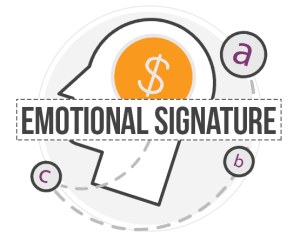It seems logical to do what everyone else is doing successfully when you get into business. It makes no sense at all to do it differently, does it? It won’t be good for your career, your team, or your bottom line.
So why is it that doing something different does create such success for specific brands?

Within Sutherland’s book are 11 rules of succeeding with nonsensical ideas, and a few of these were the subject of our conversation. Here are a few of Sutherland’s rules that we discussed:
It doesn’t pay to be logical when everybody else is being logical.
Sutherland says that if you play by the same rules as everybody else and become obsessed with comparison, you will use the same metrics as your competitors. Furthermore, when you optimize for the same parameters, you become more like your competitors and edge closer to commoditizing your product and service category.
Sutherland refers to the book Blue Ocean Strategy, which says the point of differentiation is to develop better metrics than your competitors. In other words, if you abandon that need for comparison, it’s an excellent way to find a comparative advantage.

Apple chose to ask a different question, which was, “How does the phone make you feel while you’re using it?”
Sutherland explains that by going subjective, you’ve done two things. One, you’ve escaped the dangerous trap that assumes that improvements in objective reality correlate to changes in human perception and behavior and that there’s a linear relationship between the two, which is a dangerous assumption. He reasons that you reach a point where trying to optimize the objective can result in negligible improvements that nobody cares about. Two, you gain the size of your potential solution, meaning that the space for growth increases immensely. Sure, your ability to win arguments goes down because you can’t put numbers on a lot of the subjective measures, but you have no limits to what you can do, either.
The opposite of a good idea can be another good idea.
Sutherland says that in most fields of activity, you have an optimal solution, and then you have suboptimal solutions. A classic example would be that an economist would say, “this product isn’t selling because the price is too high.” A marketing thinker would say, “this thing isn’t selling. Maybe it’s because the price is wrong.” An economist would assume there was no such thing as a price that was too low; a marketer would not necessarily agree. Therefore, Sutherland reasons, if you extend the broader thinking of the marketer to your problems, you open the opportunity for different reasonable solutions.

If you employ the usual ideas, you would ask them again or maybe ask them why they didn’t take advantage of the new offer. But what would happen if you didn’t give the customer what they said they wanted instead? Would it be the end of your career? Maybe, but then again, perhaps not.
What I have learned over the years is that customers don’t always know how to tell you what they want. Sometimes, they might not even know what they really want at all. Asking them what they want is a good idea. However, not asking them might be, too.
Of course, I don’t mean to say that you ignore customers or you give up entirely. My opposite of a good idea is to figure out for yourself what customers want. Do research that digs a little deeper and uncovers the hidden, unmet needs of your customers or potential customers. Then, use those discoveries to create a customer experience that surprises and delights customers. Our Emotional Signature® research can help you discover how you can find these ‘hidden’ things that drive value for your customers—usually, the things that customers don’t even know they want. In other words, it digs deeper to find out what customers really want and not just what they say they want.
The problem with logic is it kills off magic.
Organizations obsessed with the rational don’t see the power of the irrational. Sutherland would say that you pay the price twice because you don’t look for the “magical” (irrational) solutions, and then, when you do encounter a magical solution, you don’t believe in it or think it’s cheating. So not only do you not look for magic, but you discount it when it appears— even when it’s handed to you on a plate. Your natural reaction is to disbelieve.

So what happens if you solve overcrowding psychologically rather than numerically? Maybe you run two trains in each direction at peak hours, and these are exclusively for people with exclusive memberships. Perhaps you reward frequent travelers at this time with other perks, like streamlined luggage drop off or boarding. Maybe you make sitting less beneficial and add more benefits to standing, e.g., the chairs are in the middle of the cars, and the standing positions are in front of the windows with a shelf for your workstation. You still have a crowded train, but you have little perks that help make it feel better for the passenger. Our brain does quite a lot of minimizing regret where we possibly can. It’s the synthesis of economic value by psychological means.
By making the solution less mathematical, you make it fuzzier. Sutherland admits that in some ways, it makes this the problem more difficult because you don’t have a specific thing you’re trying to optimize. On the other hand, your potential solution space becomes enormous.
Solving problems using only one rationality is like playing golf with only one club.
Businesspeople love a precise numerical target, Sutherland says. What happens in business is the group of people who are first given a problem to solve tend to have a similar mindset, usually a financial-engineering, Newtonian- reductionist mindset.
However, when you define the problem, you define the solution, and you restrict the potential tools that can be deployed to the solution. For example, as soon as a problem is described in economic terms, economists have a monopoly on the solution. As soon as the issues defined in legal terms, lawyers take it.
The typical approach to the desired change is we deploy law first, economics second, and persuasion third. Sutherland argues that if you want behaviors to change, you should implement them in parallel. Arguably, he adds, you should try persuasion before you resort to the other two because there’s an advantage to persuasion. It’s challenging with legal and economic incentives not to penalize people unjustly.
Take the example of encouraging people to reduce carbon emissions in the UK. One of the strategies is to get people to put on washing machines, dishwashers, and clothes dryers late in the evening or at night rather than in the middle of the day. If it was it illegal to put your tumble dryer on until midnight or you charged people a tremendous amount of money for using electrical appliances during the day, both of those things would probably work. However, there are situations where running them at night wouldn’t work, like if your dryer is right over your neighbor’s bedroom in an apartment building, or if you work nights and the dryer causes a fire while you are away at work. With laws in place that do not allow for deviation, you are penalizing individuals in these situations. They are “collateral damage.”
The beautiful thing about persuasion is that if you’ve got a good enough reason, you’re free to ignore it. That isn’t true about legislation or economics, generally. As a result, there is far less collateral damage with persuasion, and therefore you can afford to be more ambitious when designing programs.

In our next issue, we will explore one more of Sutherlands’ rules as well as how to apply them in your customer experience. You might find that magic is the most logical solution you have for fostering customer-driven growth.
To hear more about this idea in more detail, listen to the complete podcast here.

What customers say they want and what they really want are often different things. It is vital to know what drives value for your organization. Our Emotional Signature research can tell you where you are compared to other organizations and what to focus on to drive value for your customers. To learn more, please click here.
Colin Shaw is the founder and CEO of Beyond Philosophy, one of the world’s leading Customer experience consultancy & training organizations. Colin is an international author of six bestselling books and an engaging keynote speaker.
Follow Colin Shaw on Twitter @ColinShaw_CX


